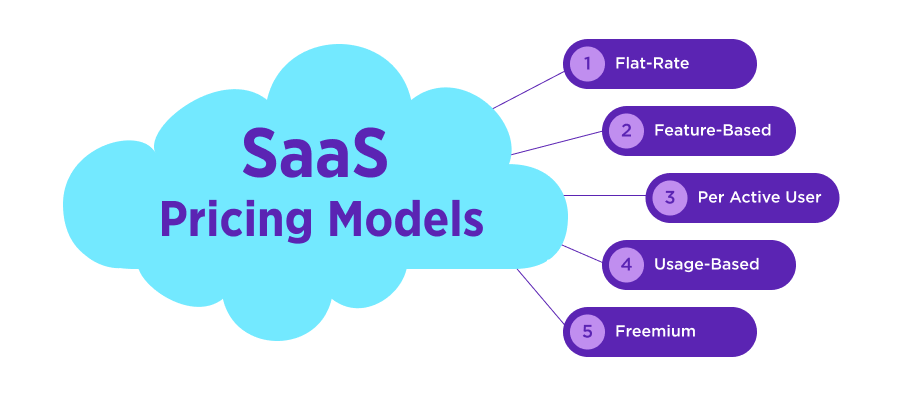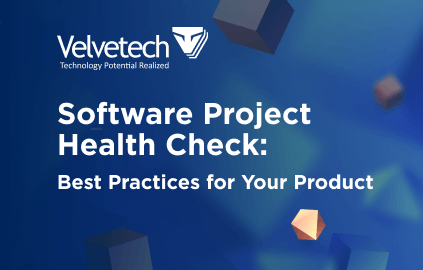Nowadays technologies become increasingly inclusive, transforming the way businesses operate in various industries. Advances in cloud computing, connectivity, mobile apps, and the like lead to the wide adoption of SaaS products. The latter offer numerous benefits like flexibility and accessibility, which makes them an appealing alternative for businesses that seek for agile software solutions.
If you decide to leverage SaaS development and come up with a new product to the market, then it’s important to think about its cost structure and monetization.
That’s where you need to determine effective SaaS pricing models and strategies aligned with your business goals. However, it can be challenging, so to help you sort things out, we have prepared a blog post.
Specifically, we will discuss:
- SaaS pricing models vs. strategies
- Things to consider before choosing your pricing option
- Leading pricing models
- Top strategies to price your solution
- Measuring the effectiveness of your approach
The Difference between SaaS Pricing Models and Strategies
Though SaaS pricing models and strategies are inseparable, they are not the same thing.
A strategy encompasses the guiding process and principles that lead a business toward determining the cost structure, positioning, value propositions, and the overall pricing philosophy. It takes into account customer needs, competitor analysis, and business goals.
At the same time, pricing models for SaaS are the specific methodologies, template options, or frameworks that determine how providers calculate the pricing for their customers. They define the structure and mechanics of the costs, outlining what customers pay and how they are billed.
Effective approach can bring numerous benefits to business. In particular, by offering competitive pricing, companies can attract new consumers and decrease churn rates. They can maximize revenue potential by accurately aligning prices with the value that their SaaS solution provides.
Discover the Key Trends of the SaaS Industry to Consider
Project Health Check
Learn the actionable steps to keep your software project on the right track, aligned with your initial goals and designated priorities.
Factors Influencing the Choice of SaaS Pricing Model

There are several important factors to take into account prior to establishing your SaaS product pricing structure.
Market and Industry. These two have a significant impact on pricing decisions. You should analyze market demand, customer preferences and their willingness to pay. Additionally, understanding the competitors and their rates helps in defining the right price point for your SaaS product.
Customer Segmentation. Possibly your future customers will have different needs, budgets, and expectations. So, it is better to segment them into groups when setting your prices. It will help you offer subscription plans affordable for each group.
Cost Flexibility. Suggesting multiple rates is a win-win option for businesses and customers. By doing it, you give flexibility to your customers to choose the plan according to their requirements and budget.
These factors can help companies make informed decisions on the most suitable pricing for their software in order to ensure long-term success in the SaaS market.
Read how Data Analysis Can Improve Your Decision-Making
Common SaaS Pricing Models

So we have explored various factors that have an impact on how to price your SaaS product. Now let’s delve straight into the different types of pricing models that can be employed to effectively monetize your SaaS offering in the B2B and B2C markets.
Flat Rate
One of the best SaaS pricing practices is a flat rate. With this model, customers are charged a standard fee on a regular basis, whether it be monthly or annually. By choosing a subscription plan, they get full access to your products, tools, and features.
Thanks to this simple yet comprehensive approach, users may enjoy the full benefits of the SaaS solutions without having to worry about usage-based prices or feature constraints.
Learn how you can Build a Successful SaaS Product
Feature-Based
In this case, clients only pay for the features they need. You can include tiers in your SaaS pricing and offer two or more packages or fixed sets of features for a specific price. This model is flexible and allows customers to upgrade subscriptions according to the changes in their requirements and reduce unnecessary costs.
To optimize the effectiveness of your feature-based cost structure, it is indeed crucial to consider various factors, such as the value of each feature, market demand, competitive positioning, and consumer preferences.
As a result, you can design a pricing model that aligns with customer expectations, increases their engagement, and therefore, maximizes your revenue potential.
Per Active User
As the name suggests, in this model subscribers are being charged based on their activity. With the per active user pricing, you charge customers based on the number of active users who access and utilize your SaaS product within a specific time period, typically a month or a year.
One of the examples of SaaS software that uses this model is Slack. Here members are billed only when they actively use the platform. Slack employs an automated system to detect inactive members and refunds client accounts accordingly.
Usage-Based
With a usage-based pricing customers pay based on their actual usage of the SaaS solution or service. Companies like Amazon or DigitalOcean use this approach to charge users in accordance with the number of gigabytes of data they use, or API requests they make.
If clients use the product more extensively, the price goes up correspondingly. And the other way round, if they use it less, the price goes down.
Freemium
The last software as a service pricing model in our list is freemium, which allows customers to initially try products for free. It enables them to assess the app’s suitability before making a purchase. The final goal of this approach is to make customers end users.
For example, one of the famous cloud storage providers that successfully leverages this SaaS pricing model is Dropbox. It suggests clients two gigabytes of free storage, and once they reach their limit they should buy more space.
Typically, when users have already stored some data in their Dropbox accounts, they will be more likely to expand their storage within the same platform rather than switching to another one.
Learn more about the Cloud Cost Optimization Techniques
Top 5 SaaS Pricing Strategies

When it comes to profitable and successful SaaS products, it is crucial to not only implement the right billing model but also come up with a robust pricing strategy. It will help you stand out in the market and differentiate your solution from competitors. Let’s explore some common approaches in this regard.
Penetration Pricing
If you are new in the market, then this approach can be the right choice. In this case, you offer lower pricing than your competitors. While this strategy can lead to a promising start, it also carries the risk of potential losses, making it more suitable for the short term.
One possible tactic is to employ penetration pricing initially, attract customers, and once you’ve gained market share you can gradually raise your rates.
Cost-Plus Pricing
Another strategy that can serve as a starting point for SaaS companies is cost-plus. In short, you include target profit margin and product development costs on your final rate. It aims to cover your expenses and maintain financial stability.
While there can be a high temptation to consider solely the investments you put in your software development, it’s also crucial to base your pricing on the value that customers will get from using the product. And here the next strategy may come in handy.
Value-Based Pricing
“Price is what you pay, value is what you get.”
— Warren Buffett, CEO of Berkshire Hathaway
This model prioritizes the benefits, outcomes, and value that customers derive from using the offering, rather than focusing on costs or competitor prices. It considers the positive impact the product has on clients as well as the value it provides in terms of addressing problems, meeting needs, or improving their entire experience.
Ultimately, it can help enhance customer satisfaction, differentiate products or services in the market, and maximize profitability.
User-Driven Approach
Watch our webinar and learn the top ways of reducing poor user satisfaction, low adoption rates, and decreased loyalty.
Prestige Pricing
If you offer unique SaaS products or services, you can position them as high-end. You can implement this approach successfully by clearly understanding your target audience, their specific needs and preferences. The prestige pricing is more suitable for well-known brands which can charge higher costs from high-profile companies.
Skimming Pricing
Skimming or promotional pricing is the strategy of high initial prices for products when they first enter the market. Costs typically decrease gradually over time. For example, Apple lowers the prices of its items only when new models are released.
Sony often works with the same principle. It sets higher initial prices to attract keen players who are anxious to try out the latest gaming technology. Over time, the cost lowers, becoming more affordable for a broader audience.
How to Measure the Effectiveness of Your SaaS Pricing Model

After exploring the most common pricing models and reviewing the top strategies applicable to any SaaS business, including enterprise, it is crucial to assess how well your chosen approach aligns with your organization’s needs. To ensure the effectiveness of your pricing strategy, let’s delve into the key measures that can be utilized for evaluation purposes.
LTV/CAC Ratio. Establishing your LTV (lifetime value) and CAC (customer acquisition costs) ratios are important. It compares the value a customer brings to the business over their lifetime to the cost of acquiring that customer. The ratio of these two should always be greater than one in order to avoid losing money on every consumer.
Gross Monthly Recurring Revenue (MRR). Measuring the percentage of revenue lost due to license cancellations or downgrades is an important step to get an entire picture of the company’s total loss in terms of percentage. It will help take needed steps to mitigate losses and maintain a stable revenue stream.
Expansion Monthly Recurring Revenue. It tracks revenue increase due to upsells, cross-sells, or upgrades within the client base. MRR demonstrates how existing consumers produce more income and value for your product, leading to higher demand.
Upgrade Monthly Recurring Revenue. It shows the percentage of existing customers who choose to upgrade their subscription plans to more advanced. Generally, if you want to encourage your clients to upgrade their subscriptions, you can add new features.
Building a Successful Pricing Model
We have covered how consistent SaaS pricing strategies and models can help SaaS companies gain profits and remain competitive. By understanding your target consumers’ needs you can adopt the right approach and implement outstanding SaaS products.
However, it can be challenging to define the starting point. Thus, our team of professionals is here to assist you. We offer SaaS development services tailored to companies across various industries. Take the first step to build your successful SaaS solution or service. Contact us today.











